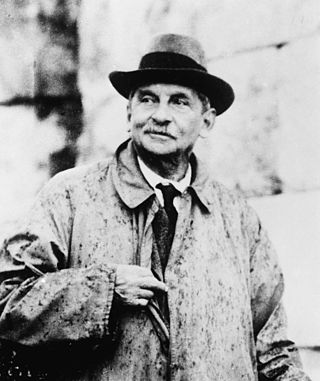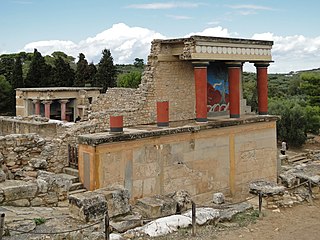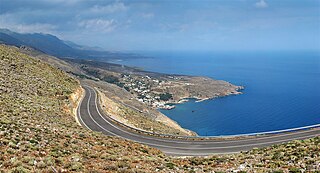Related Research Articles

Sir Arthur John Evans was a British archaeologist and pioneer in the study of Aegean civilization in the Bronze Age.

Knossos is a Bronze Age archaeological site in Crete. The site was a major center of the Minoan civilization and is known for its association with the Greek myth of Theseus and the minotaur. It is located on the outskirts of Heraklion, and remains a popular tourist destination. Knossos is considered by many to be the oldest city in Europe.

Spyridon Marinatos was a Greek archaeologist who specialised in the Bronze Age Minoan and Mycenaean civilizations. He is best known for the excavation of the Minoan site of Akrotiri on Santorini, which he conducted between 1967 and 1974. A recipient of several honours in Greece and abroad, he was considered one of the most important Greek archaeologists of his day.

Sfakiá is a mountainous area in the southwestern part of the island of Crete, in the Chania regional unit. It is considered to be one of the few places in Greece that have never been fully occupied by foreign powers. With a 2021 census population of 2,002 inhabitants living on a land area of 467.589 km2 (180.537 sq mi), Sfakia is one of the largest and least densely populated municipalities on the island of Crete. The etymology of its name is disputed. According to the prevailing theory, it relates to its rugged terrain, deriving from the ancient Greek word σφαξ, meaning land chasm or gorge.

Oliver Rackham was an academic at the University of Cambridge who studied the ecology, management and development of the British countryside, especially trees, woodlands and wood pasture. His books included Ancient Woodland (1980) and The History of the Countryside (1986).

The Minoan eruption was a catastrophic volcanic eruption that devastated the Aegean island of Thera circa 1600 BCE. It destroyed the Minoan settlement at Akrotiri, as well as communities and agricultural areas on nearby islands and the coast of Crete with subsequent earthquakes and paleotsunamis. With a Volcanic Explosivity Index (VEI) of 6, it resulted in the ejection of approximately 28–41 km3 (6.7–9.8 cu mi) of dense-rock equivalent (DRE), the eruption was one of the largest volcanic events in human history. Since tephra from the Minoan eruption serves as a marker horizon in nearly all archaeological sites in the Eastern Mediterranean, its precise date is of high importance and has been fiercely debated among archaeologists and volcanologists for decades, without coming to a definite conclusion.
The Folklore Society (FLS) is a registered charity under English law based in London, England for the study of folklore. Its office is at 50 Fitzroy Street, London home of the Royal Anthropological Institute of Great Britain and Ireland.
Antony Charles Thomas, was a British historian and archaeologist who was Professor of Cornish Studies at Exeter University, and the first Director of the Institute of Cornish Studies, from 1971 until his retirement in 1991. He was recognised as a Bard of the Cornish Gorseth with the name Gwas Godhyan in 1953.

Minoan palaces were massive building complexes built on Crete during the Bronze Age. They are often considered emblematic of the Minoan civilization and are modern tourist destinations. Archaeologists generally recognize five structures as palaces, namely those at Knossos, Phaistos, Malia, Galatas, and Zakros. Minoan palaces consisted of multistory wings surrounding an open rectangular central court. They shared a common architectural vocabulary and organization, including distinctive room types such as the lustral basin and the pillar crypt. However, each palace was unique, and their appearances changed dramatically as they were continually remodeled throughout their lifespans.
John Peter Oleson is a Canadian classical archaeologist and historian of ancient technology. His main interests are the Roman Near East, maritime archaeology, and ancient technology, especially hydraulic technology, water-lifting devices, and Roman concrete construction.
The Graduate Group in the Art and Archaeology of the Mediterranean World (AAMW) is an interdisciplinary program for research and teaching of archaeology, particularly archaeology and art of the ancient Mediterranean, Egypt, Anatolia, and the Near East, based in the Penn Museum of the University of Pennsylvania.
Vrokastro was an ancient Minoan civilization settlement in the Lasithi regional unit of eastern Crete, Greece. It overlooks the Gulf of Mirabello.

Ha Gorge is a narrow gorge, at the Monasteraki Dakos, on the eastern part of the island of Crete in Greece. It is located in the west slope of Thrypti mountain range, and exits east of Vasiliki village in the plain of Ierapetra. From this location scenic views overlook Pahia Amos and the bay. Being practically inaccessible to people, the gorge maintains a rich and diverse flora and fauna. Its depth is about 1,000 metres (3,300 ft) and the fissure is said to be one of the largest in the world. Late Minoan IIIC sites are in the area.

The Kavousi Project was a multidisciplinary program of archaeological investigations in the area of Kavousi, a historic village at the eastern end of the Gulf of Mirabello in East Crete, Greece. The objective of the project was to restudy a number of archaeological sites originally investigated by the pioneering American archaeologist Harriet Boyd [Hawes] in the early years of the 20th century, focusing on the Greek Dark Age sites of Kavousi Vronda and Kavousi Kastro, but also including tombs at nearby Aloni, Plaï tou Kastrou, and Skouriasmenos, all located in the northern foothills of the Thripti Mountains of eastern Crete.
Nicoletta Momigliano is an archaeologist specialising in Minoan Crete and its modern reception.

A. Jennifer Price was an archaeologist and academic, specialising in the study of Roman glass. She was professor emerita in the department of archaeology at Durham University.
Susan Sherratt is Reader in Mediterranean Archaeology at the University of Sheffield. Her research focuses on the archaeology of the Bronze and Early Iron Ages of the Aegean, Cyprus and the eastern Mediterranean, especially trade and interaction within and beyond these regions.
Dawn Marie Hadley is a British historian and archaeologist, who is best known for her research on the Anglo-Saxon and Viking Age periods, the study of childhood, and gender in medieval England. She is a member of the Centre for Medieval Studies and the department of archaeology at the University of York.
Lucia Nixon is a Classical Archaeologist at the University of Oxford. She was Senior Tutor at St Hilda's College, Oxford. Since 1987, she has co-directed the Sphakia Survey with Jennifer Moody, which excavates and surveys the Sphakia region of south-west Crete, from ca. 3000 BCE - 1900 CE.

Richard "Dick" Hope Simpson (1930–2016) was a British Classical archaeologist, known for his work in archaeological survey and the study of Mycenaean Greece. For most of his career, he taught at Queen's University at Kingston in Kingston, Ontario.
References
- ↑ "Profile for Jennifer Moody at UT Austin".
- ↑ "Browse Fellows by Area: The Social Sciences - MacArthur Foundation". Archived from the original on 2010-04-04. Retrieved 2010-04-20.